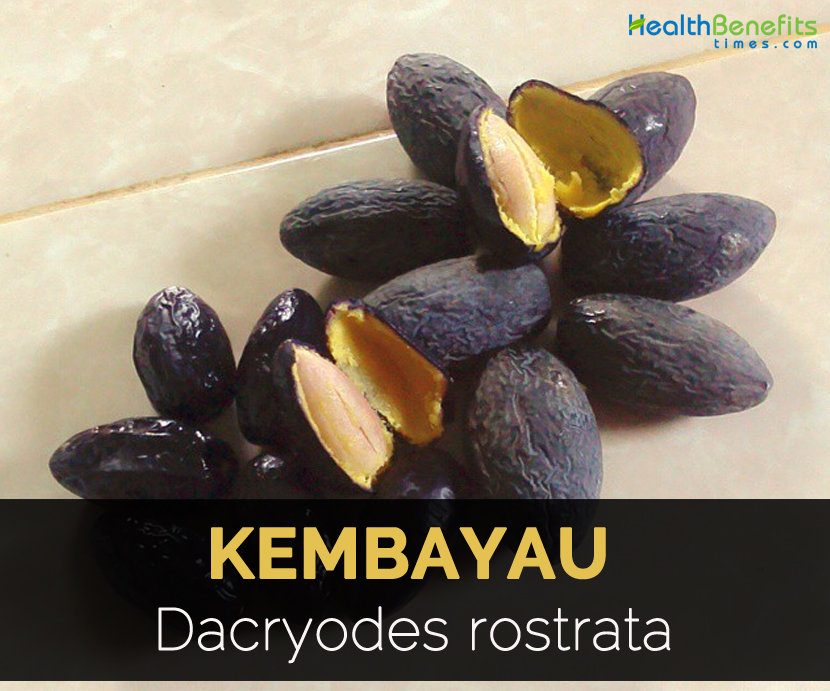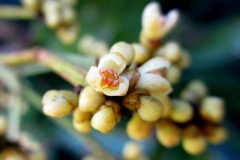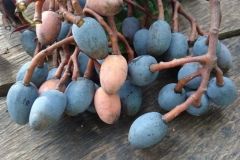This evergreen and perennial tree grows to the height of 40 meters with 1 meter trunk diameter and low buttresses. Leaves are pinnate, alternate . Leaflets are papery; ovate-oblong with asymmetrical base, leaf apex is elongated and widened at the tip. Panicles are axillary which is combined into a terminal inflorescence. Flowers are small, three to numerous, yellowish-white and 3 mm across. Male flowers have six stamens connate to periphery of disk. Female flowers have six staminodes. Fruit is ovoid to oblongoid and fleshy drupe which measures 2–4 cm × 1–2 cm and is yellowbrown to purplish black which contains one hard seed. Branchlets are 4-10 mm thick, glabrous and lenticellate. Leaves are usually glabrous. Leaflets are ovate to oblong, rigid, glabrous or pubescent underneath and about 3.5-20 by 1.5-10 cm. Flowers are tomentose and about 2-4 mm long. Stamens are distinctly longer in comparison to epipetalous ones sometimes all adnate to the disk. Male flowers have pistil which is strongly to nearly entirely reduce. Fruits are slightly oblique, ovoid to oblong and about 1.75-3.5 by 0.75-1.75 cm.
Culinary uses
Pulp is preserved in salt and fried as dish.
References:
https://www.itis.gov/servlet/SingleRpt/SingleRpt?search_topic=TSN&search_value=28767#null
https://en.wikipedia.org/wiki/Dacryodes_rostrata
http://tropical.theferns.info/viewtropical.php?id=Dacryodes+rostrata
Comments
| Kembayau Quick Facts | |
|---|---|
| Name: | Kembayau |
| Scientific Name: | Dacryodes rostrata |
| Origin | The species is found in Indo-China, Thailand, Peninsular Malaysia, Sumatra, Sulawesi, Borneo (Sarawak, Brunei, Sabah, West-, Central- and East-Kalimantan) and the Philippines. |
| Colors | Yellowbrown to purplish black |
| Shapes | Ovoid to oblongoid |
| Flesh colors | Yellow |
| Name | Kembayau |
|---|---|
| Scientific Name | Dacryodes rostrata |
| Native | The species is found in Indo-China, Thailand, Peninsular Malaysia, Sumatra, Sulawesi, Borneo (Sarawak, Brunei, Sabah, West-, Central- and East-Kalimantan) and the Philippines. |
| Name in Other Languages | Borneo: Ampadu Kalui, Kambayan, Kalasu, Kedongdong, Karamu, Kelamok Maruk, Kembayan Burong, Kembayan Aie, Kembayau, Kembayau Lamak, Kembayan Utan, Kembayau Teta, Keramuh, Kumabang, Masam, Langsat-Langsat, Merading, Njihah, Merasam, Peninasan, Tindau, Piramuh, Ungit; Brunei: Ungit; Indonesia:- Sumatra: Asem Begomdang, Bangka: Rengas Burung, Kalimantan: Kembajau, General: Kayu Minyak, Kedondong, Punan Malinau, East Kalimantan: Keramuh, Lundanye, East Kalimantan: Kedamu, Merap, East Kalimantan: Buwa Keramau, Kenyah Uma’, East Kalimantan: Keramu; Malaysia:- Peninsular: Kedondong Kerut, Kembayau, Sarawak: Kembayau, Kelamok Maruk, Keramoh, Sabah: Kamubang; Philippines:- Bikol: Palaspas, Bisaya: Pili-Hanai, Lanao: Lunai; Vietnamese: Trám Xuyên |
| Plant Growth Habit | Evergreen, perennial tree |
| Plant Size | 40 m tall |
| Leaf | Alternate, pinnate |
| Flower | 3 mm across, yellowish–white |
| Fruit shape & size | Ovoid to oblongoid, fleshy drupe, 2–4 cm × 1–2 cm |
| Fruit color | Yellowbrown to purplish black |
| Flesh color | Yellow |
| Seed | Large, light brown to cream |





